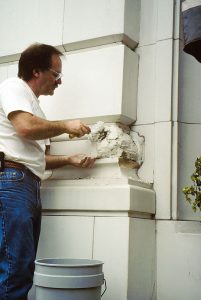Hanover, MD After years of working as a stone craftsman, company founder Dennis Rude became frustrated with the performance of existing masonry repair products. He researched European methods, then pioneered the scientific approach to masonry restoration in the U.S. Today Cathedral Stone Products bridges past and future with a full line of exterior restoration systems – backed by training, technical support and laboratory services.
Cathedral Stone Products, Inc. helps protect real estate in New York and beyond. Historic structures and even newer buildings may show signs of deteriorating masonry. Mortars as well as cast forms and concrete surfaces are often the first to show the effects of airborne contaminants and freeze-thaw cycling. In addition, soft stone such as limestone, terracotta and marble are prone to staining and discoloration.
As a general rule, restoration is generally less expensive than replacement if at least 50% of the original stone or masonry structure remains. It also may be the best or only option over large areas where access is difficult or limited.
Systems from Cathedral Stone include: 1. Masonry Restoration Mortars and Injection Grouts, 2. Masonry Surface Cleaning and Preparation Products, and 3. Mineral Coatings and Masonry Staining Systems. Training, technical support and laboratory services also can make a difference. Over the past 35 years, these specialized systems have been instrumental in restoring such landmarks as the Javits Center, the Empire State Building, the Ellis Island Immigration Building, the U.S. Capitol Building and the Washington Monument.
The company’s success all began with a humble stone craftsman dedicated to improving the future of stone masonry.
Early Career
Company founder and owner Dennis Rude began his career in the early sixties as an apprentice for the Stonecutters and Carvers Association of North America. He excelled in precision cutting, masonry repairs and detailed restorations. He could restore or recreate elaborate architectural forms and figures in granite, marble or limestone.
After four years of service in the U.S. Navy, Rude returned to masonry as a stonecutter for the Washington National Cathedral in Washington, D.C. The neo-Gothic structure, which began construction around 1907, was still not yet complete in the late ‘60s, early ‘70s, and some of the original stonework required repointing or repair.
Rude’s extensive work and artisanship at the national historic site developed into an ongoing relationship with the Cathedral, and he became superintendent of the National Cathedral Stone Works in 1977. A year later, he became the owner, and soon renamed it Cathedral Stone Company.
Growing Reputation
Under Rude’s leadership, the company’s reputation quickly grew in the Washington, D.C. area. Cathedral Stone began cutting and setting stone and restoring exteriors for the White House, the U.S. Capitol Building, the Washington Monument and the Pentagon. Work expanded to other public and private institutions as well as stately homes in the region (and later north to Baltimore and New York).
While working on projects, Rude noted the many types of significant masonry failures – fractures, displacements; pitted or cracked forms; loose stone or supports; mortar bulging from brick; spalling concrete, missing anchors, etc. He carefully cataloged the failures. Then he began a quest to investigate their causes and master the restoration techniques that could best repair and prevent them.
His search led him on a tour through several European cities – havens of centuries-old historical structures where masonry failures were often studied in laboratories. During this tour, he met world-renowned stonemason Heinz Jahn at a laboratory in Holland. Jahn was known for investigating restoration failures and modifying mortars to address the challenges of specific substrates. Rude admired the scientific approach, and his friendship with Jahn led to the introduction of JAHN mortars in the U.S.
The Future
Ever since Rude formed Cathedral Stone Products in 1982, restoration mortars and injection grouts have been a core focus. Today, Cathedral Stone produces a full-range of systems, and distributes products through a nationwide network. Under Rude’s direction, the company continues to use scientific analysis to advance masonry restoration systems.
On a national scale, the company is expanding development to help government planners respond to aging infrastructure. “Bridges, tunnels, and supports along roadways and at transportation hubs all require better solutions that not only repair underlying problems but are designed to help reduce maintenance and failures,” Rude says. The scientific approach in this area can also benefit buildings.
The company is a sponsor of the annual conference of the Association of Preservationists Technology, and offers special expertise in this area including material analysis and color-matching services.
Cathedral Stone continues to innovate as well with more environmentally sustainable products. One new product of special interest to real estate managers is a waterless cleaner that can clean masonry without scrubbing. The masonRe Latex 20 cleaner dries to a rubbery film which is simply stripped away after about 24 hours, bringing dust and grime with it. The heavy-duty cleaner works into pores and is powerful enough to remove even soot and nicotine. And because it does not require water for application, it can help buildings, and cities, reduce water use.
 His early career could take him to unexpected places, such as atop the Iwo Jima Memorial at the Quantico Marine Base in Virginia.
His early career could take him to unexpected places, such as atop the Iwo Jima Memorial at the Quantico Marine Base in Virginia.Training a New Generation
Cathedral Stone became a major force in the New York metro area during the late ‘80s and early ‘90s. Advancing the state-of-the-art in masonry restoration and repair systems requires not just the right products but also knowledge and talent. The company conducts AIA-credited seminars and hands-on workshops for architects, engineers and construction specifiers throughout the year, as well as certification programs for masonry contractors. “Our goal is to help those attending our workshops preserve the integrity and splendor of New York architecture for the next generation,” Rude said.
The seminars credited by the American Institute of Architects (AIA) provide an overview of options for masonry restoration and stabilization systems, including injection mortars and pinning systems, casting systems, as well as surface preparation and cleaning products, and coating systems that allow masonry to breathe so it will not peel or crack.
“We always like to give back,” Rude said. This year, the company provided training and other support as an in-kind sponsor of a Preservation Training Program for youth at the Woodlawn Cemetery. The program, which helps youth in the Bronx, is a collaboration between Woodlawn Conservancy, World Monuments Fund, and the International Masonry Institute.

Sign up is quick, easy, & FREE.








